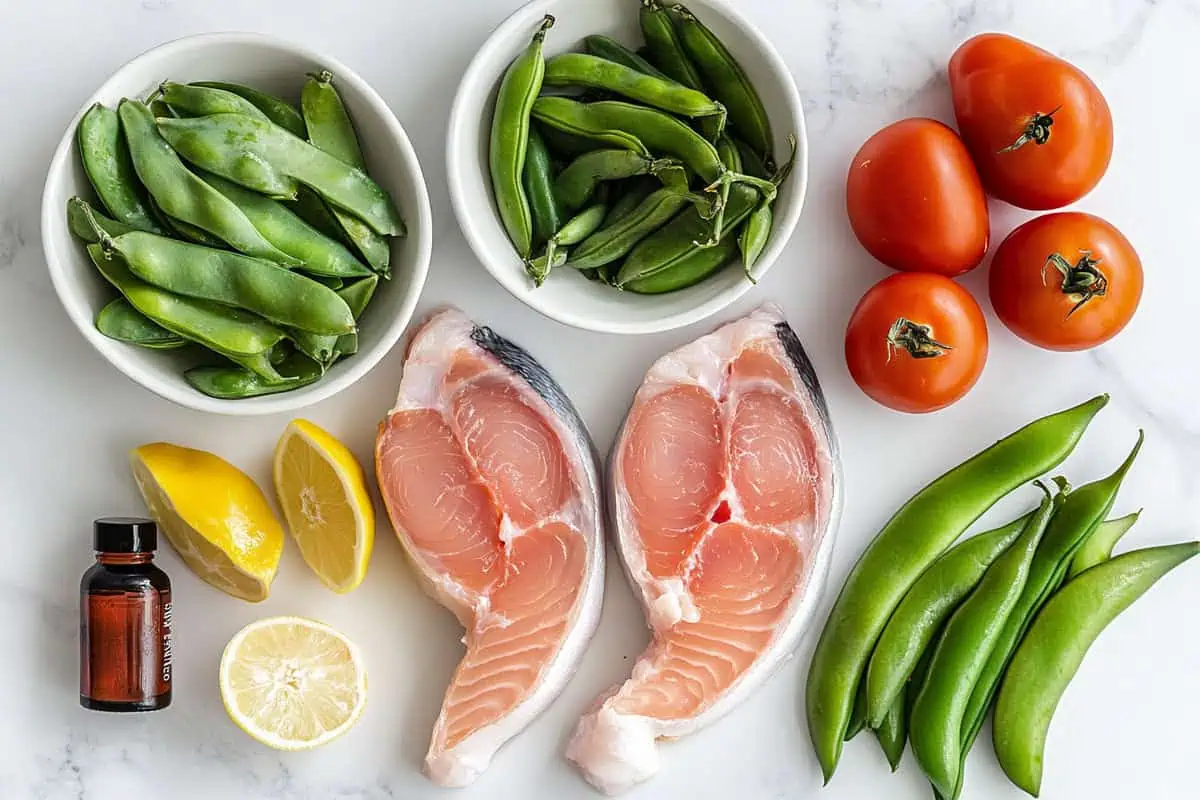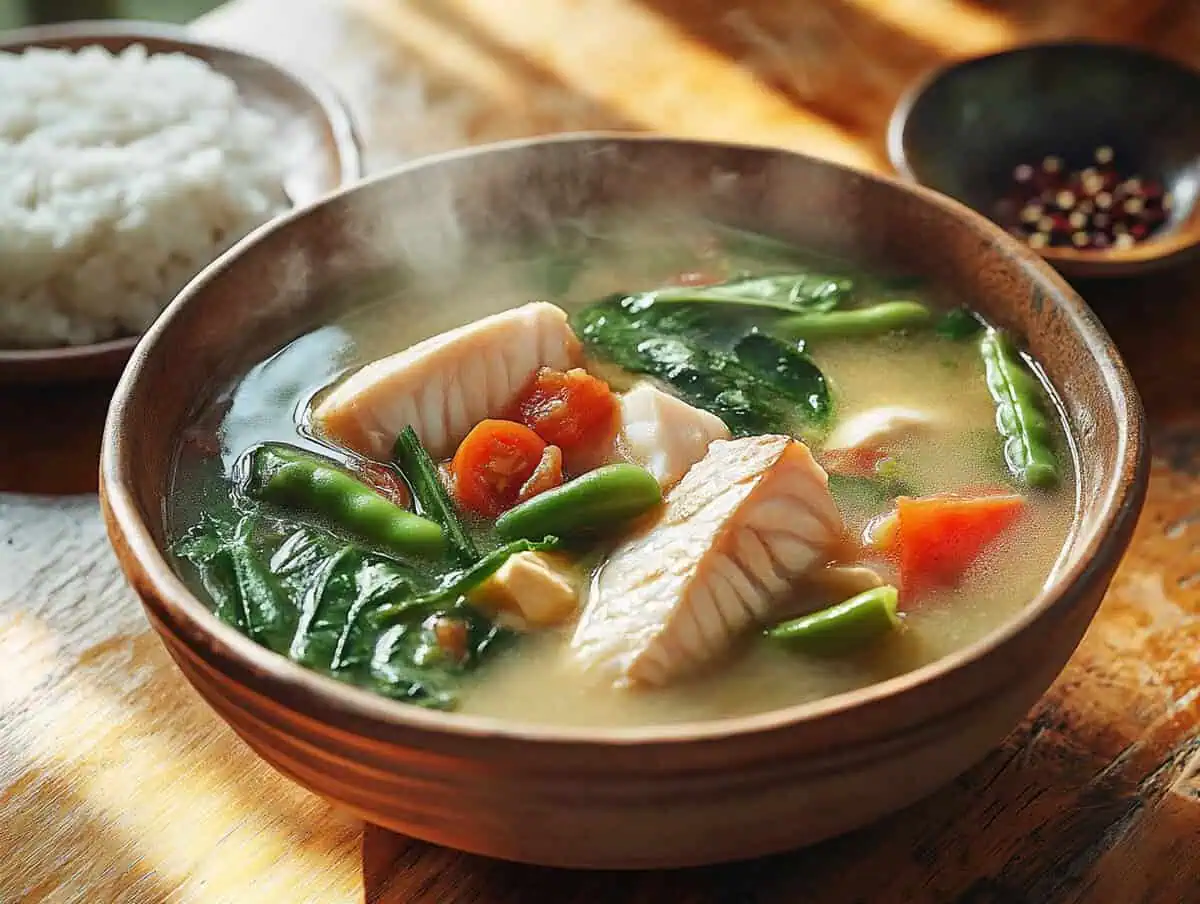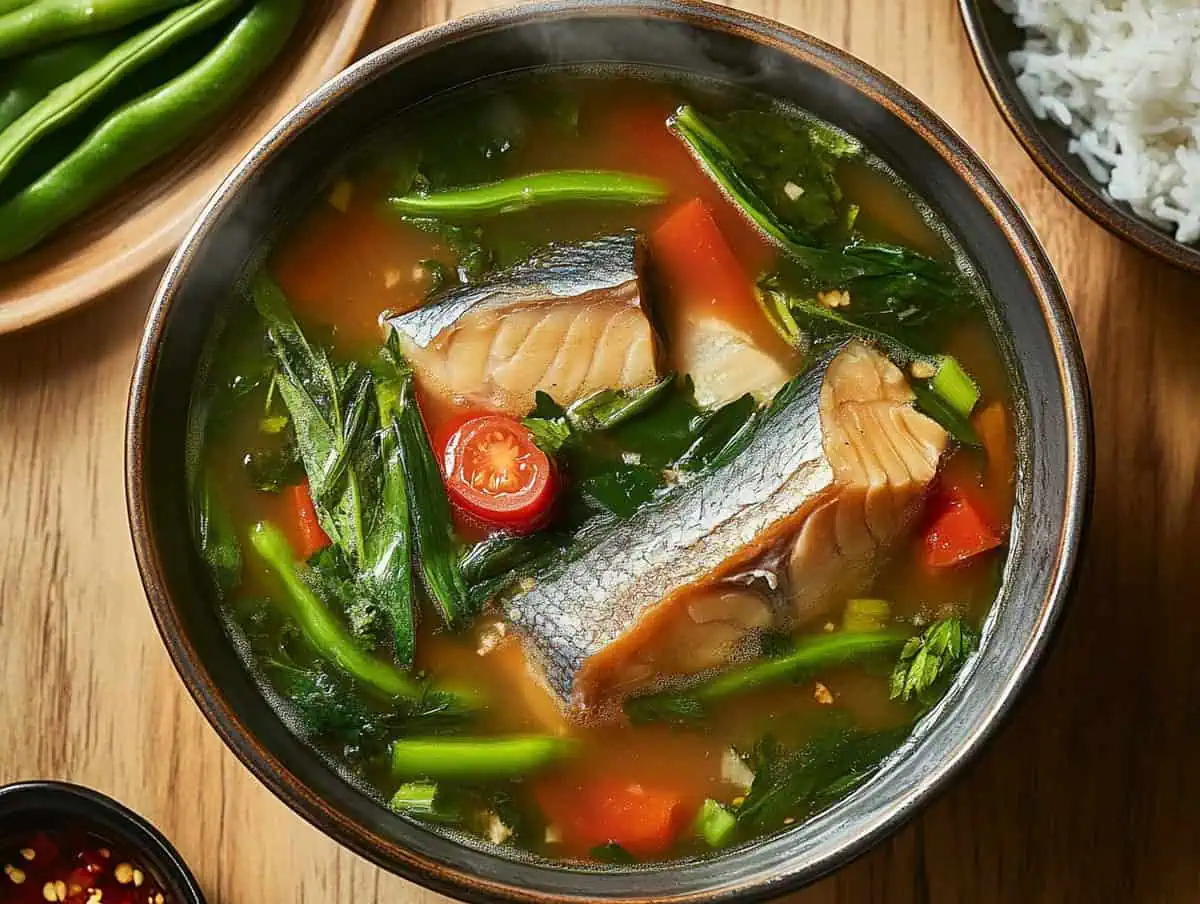Today we are going to cook the perfect Sinigang na Bangus recipe! This dish holds a special place in my heart as it reminds me of rainy afternoons at my grandmother's table.
The tangy tamarind broth warms you from the inside, while the tender milkfish and fresh vegetables create a balanced meal that's both comforting and healthy. I've perfected this recipe over years of Sunday family lunches, and I'm excited to share it with you today.
It's surprisingly simple to make, requiring just one pot and about 40 minutes of your time, but the flavors will make everyone think you spent hours in the kitchen.
What is Sinigang na Bangus?
Sinigang na Bangus is a traditional Filipino sour soup featuring milkfish (bangus) as the star ingredient. This beloved dish is characterized by its tangy tamarind-based broth and an assortment of fresh vegetables.
It's a staple in Filipino households, especially during rainy seasons, and is considered one of the national comfort foods of the Philippines. The sour broth helps stimulate appetite and the combination of fish and vegetables makes it a complete, nutritious meal when served with steamed rice.
Jump to:
Why You'll Love This Recipe
- Quick and easy - perfect for busy weeknights
- Nutritious - packed with protein and vegetables
- Budget-friendly - uses simple, accessible ingredients
- Comforting - the ultimate Filipino comfort food for rainy days
- Versatile - easily customizable with seasonal vegetables
Ingredients
I've carefully selected these ingredients to create the perfect balance of flavors and textures in this Sinigang na Bangus. The milkfish provides a delicate sweetness, while the Knorr mix offers convenient sourness without compromising on taste.
Fresh vegetables add crunch, color, and nutrition, making this a complete one-pot meal. The fish sauce adds that essential umami depth that makes Filipino cuisine so special.

- 2 lbs. bangus (milkfish), cleaned and sliced into 2-inch pieces
- 1 40g pack Knorr Sinigang sa Sampaloc Mix (Original)
- 1 bunch fresh kangkong (water spinach) leaves
- 12 pieces sitaw (snake beans), cut into 2-inch pieces
- 6 to 8 pieces okra
- 2 pieces long green pepper (siling pansigang)
- 1 medium tomato, wedged
- 1 medium yellow onion, wedged
- 2 ½ tablespoons fish sauce (patis)
- ¼ teaspoon ground black pepper
- 2 quarts water
- Steamed rice, for serving
- Optional: fresh calamansi or lime wedges
Equipment
- Large pot or Dutch oven (at least 4-quart capacity)
- Sharp knife for cutting vegetables and fish
- Cutting board
- Measuring spoons
- Large ladle for serving
- Serving bowl (preferably deep)

How To Make
- Prepare your pot - Heat a large cooking pot and pour in 2 quarts of water.
- Add aromatics - Once the water starts to heat up, add tomato and onion wedges. Bring to a boil.
- Cook the fish - Carefully place the bangus pieces into the boiling broth. Cover and cook over medium heat for 8-12 minutes, or until the fish is nearly cooked through.
- Add the souring agent - Stir in the Knorr Sinigang sa Sampaloc Mix. Allow it to dissolve completely and cook for an additional 2 minutes.
- Add firm vegetables - Add the long green peppers, snake beans, and okra to the pot. Stir gently to avoid breaking the fish. Cover and cook for 5-7 minutes until vegetables are tender but still crisp.
- Season - Add fish sauce and ground black pepper. Stir carefully.
- Finish with leafy greens - Add the kangkong leaves on top of the soup. Cover the pot and turn off the heat. Let it stand for 5 minutes to allow the residual heat to wilt the greens without overcooking them.
- Serve - Transfer to a large serving bowl. Serve hot with steamed rice and optional calamansi or lime wedges on the side.

Tips from Lola's Kitchen
- Choose the freshest bangus - Look for clear, bright eyes and red gills when selecting your milkfish. The fresher the fish, the better your sinigang will taste.
- Don't stir too much - Once the fish is in the pot, avoid excessive stirring to prevent the fish from breaking apart. Instead, gently shake the pot to distribute the heat.
- Layer your vegetables - Add harder vegetables like okra and snake beans first, followed by more delicate ones like kangkong. This ensures everything is cooked perfectly.
- Serve immediately - Sinigang is best enjoyed freshly cooked when the vegetables are still vibrant and have the perfect texture.
- Prepare a fish sauce dipping sauce - In a small saucer, combine 2-3 tablespoons of fish sauce with sliced bird's eye chilies for an extra flavor boost when eating.
Substitutions
- No fresh bangus? - Other firm white fish like tilapia, red snapper, or sea bass work well in this recipe.
- No Knorr Sinigang mix? - Use 2-3 tablespoons of tamarind paste, or 4-5 pieces of fresh tamarind boiled and strained.
- No kangkong? - Substitute with spinach, bok choy, or other leafy greens.
- No sitaw? - Green beans or string beans are excellent alternatives.
- No okra? - Try using eggplant or radish instead for a different but still authentic version.
Troubleshooting
- Fish is falling apart - You may have overcooked it or stirred too vigorously. Next time, reduce cooking time or handle more gently.
- Broth isn't sour enough - Add more sinigang mix or tamarind paste to achieve your desired level of sourness.
- Vegetables are too soft - You've likely overcooked them. Next time, reduce cooking time or add more delicate vegetables later in the process.
- Broth is too salty - Add a cup of water to dilute or balance with a squeeze of calamansi or lime juice.
Storage & Reheating
- Refrigerator - Store leftover sinigang in an airtight container for up to 2 days. Keep the fish and vegetables submerged in the broth to prevent them from drying out.
- Freezing - Not recommended as the texture of both fish and vegetables will deteriorate significantly.
- Reheating - Gently reheat in a pot over medium-low heat until just warmed through. Avoid boiling as this will overcook the fish and vegetables. For best results, remove the fish pieces before reheating and add them back in at the last minute.

FAQ
Can I make this sinigang recipe in advance?
While it's best freshly made, you can prepare the broth and cook the fish ahead of time, then add and cook the vegetables just before serving.
Is sinigang healthy?
Yes! This dish is packed with protein from the fish and nutrients from the various vegetables, making it a well-balanced meal.
Can I use a whole bangus instead of sliced pieces?
Yes, you can use a whole bangus, but increase the cooking time by about 5-10 minutes and be careful when turning the fish.
What makes sinigang sour?
Traditionally, sinigang gets its sourness from tamarind (sampaloc). The Knorr mix in this recipe contains tamarind powder for convenience.
What can I serve with sinigang na bangus?
Steamed white rice is the traditional accompaniment. A side of fish sauce with chili (patis with sili) is also commonly served as a dipping sauce.
Can I add other vegetables to this recipe?
Absolutely! Traditional additions include radish, taro, eggplant, and various local greens. Feel free to customize based on what's available.
Related
Looking for other recipes like this? Try these:

Sinigang na Bangus (Filipino Milkfish Sour Soup)
Ingredients
- 2 lbs. bangus milkfish, cleaned and sliced into 2-inch pieces
- 1 40 g pack Knorr Sinigang sa Sampaloc Mix Original
- 1 bunch fresh kangkong water spinach leaves
- 12 pieces sitaw snake beans, cut into 2-inch pieces
- 6 to 8 pieces okra
- 2 pieces long green pepper siling pansigang
- 1 medium tomato wedged
- 1 medium yellow onion wedged
- 2 ½ tablespoons fish sauce patis
- ¼ teaspoon ground black pepper
- 2 quarts water
- Steamed rice for serving
- Optional: fresh calamansi or lime wedges
Instructions
- Prepare your pot - Heat a large cooking pot and pour in 2 quarts of water.
- Add aromatics - Once the water starts to heat up, add tomato and onion wedges. Bring to a boil.
- Cook the fish - Carefully place the bangus pieces into the boiling broth. Cover and cook over medium heat for 8-12 minutes, or until the fish is nearly cooked through.
- Add the souring agent - Stir in the Knorr Sinigang sa Sampaloc Mix. Allow it to dissolve completely and cook for an additional 2 minutes.
- Add firm vegetables - Add the long green peppers, snake beans, and okra to the pot. Stir gently to avoid breaking the fish. Cover and cook for 5-7 minutes until vegetables are tender but still crisp.
- Season - Add fish sauce and ground black pepper. Stir carefully.
- Finish with leafy greens - Add the kangkong leaves on top of the soup. Cover the pot and turn off the heat. Let it stand for 5 minutes to allow the residual heat to wilt the greens without overcooking them.
- Serve - Transfer to a large serving bowl. Serve hot with steamed rice and optional calamansi or lime wedges on the side.
Tips from Lola's Kitchen
- Choose the freshest bangus - Look for clear, bright eyes and red gills when selecting your milkfish. The fresher the fish, the better your sinigang will taste.
- Don't stir too much - Once the fish is in the pot, avoid excessive stirring to prevent the fish from breaking apart. Instead, gently shake the pot to distribute the heat.
- Layer your vegetables - Add harder vegetables like okra and snake beans first, followed by more delicate ones like kangkong. This ensures everything is cooked perfectly.
- Serve immediately - Sinigang is best enjoyed freshly cooked when the vegetables are still vibrant and have the perfect texture.
- Prepare a fish sauce dipping sauce - In a small saucer, combine 2-3 tablespoons of fish sauce with sliced bird's eye chilies for an extra flavor boost when eating.
The Story Behind Sinigang na Bangus
Sinigang na Bangus has been a cornerstone of Filipino cuisine for centuries, tracing its origins to pre-colonial Philippines when indigenous communities created dishes using locally available ingredients. The name "sinigang" comes from the Tagalog word "sigang," which means "to stew" or "to boil with sourness," highlighting the dish's defining characteristic.
Bangus, or milkfish, holds special significance in Filipino culture as the national fish of the Philippines. Its farming dates back over 800 years, making it one of the oldest forms of aquaculture in the world. The combination of this culturally important fish with the sour tamarind broth represents the perfect marriage of the Philippines' agricultural heritage and its abundance of coastal resources.
Traditional sinigang was made using fresh sampaloc (tamarind) pods, which were boiled, mashed, and strained to create the signature sour broth. While modern conveniences like tamarind powder mixes have simplified the cooking process, the essential flavor profile remains unchanged from what Filipino ancestors enjoyed generations ago.
The dish varies from region to region across the Philippine archipelago. In the northern provinces, sinigang might include more root vegetables like radishes, while southern variations might incorporate more tropical fruits like green mangoes or santol to achieve the desired sourness. This regional diversity reflects the Philippines' varied geography and cultural influences.
Sinigang na Bangus isn't just a meal; it's a cultural symbol that brings families together. During the rainy season, which spans several months in the Philippines, this hot soup is particularly cherished for its ability to warm both body and spirit. Many Filipinos recall memories of their mothers or grandmothers preparing large pots of sinigang during stormy weather, the aroma filling their homes with comfort and familiarity.
Today, this humble dish has found its way into high-end restaurants and international Filipino food establishments, though many will argue that the best versions are still found in home kitchens using recipes passed down through generations. Its perfect balance of sour, savory, and fresh flavors represents the essence of Filipino cooking philosophy – simple ingredients transformed into something extraordinary through thoughtful preparation.










Comments
No Comments